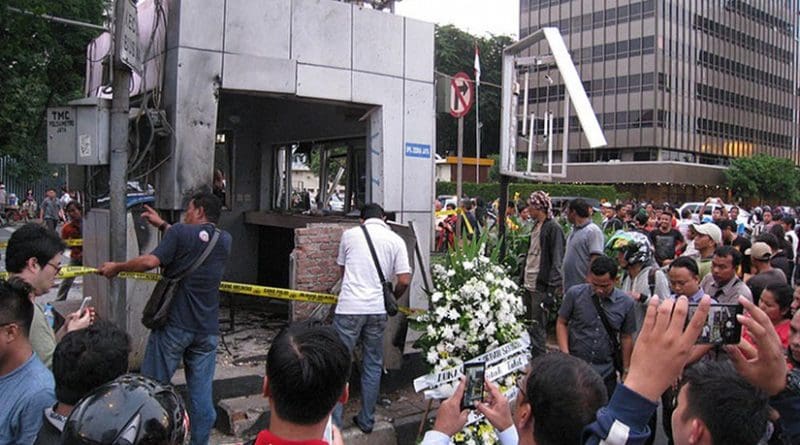Mass Casualty Urban Terrorist Assaults – Analysis
By RSIS
Attacks on major cities or capitals are becoming more frequent and range from the use of primitive tactics, techniques and procedures (TTPs) to the increasingly more sophisticated TTPs, which involve multiple personnel attacking either one or several targets simultaneously such as the rolling attack in Jakarta on 14 January 2016. Why are cities targets and how are terrorists targetting cities?
ByAhmed Salah Hashim*
In 2015, capitals around the world suffered devastating assaults by terrorists. Paris was subject to two devastating terrorist events, Beirut was hit by terrorists linked to Islamic State in an attack that was largely ignored, while further to the east, Iraqi cities have been subjected to a wide range of terrorist assaults, the like of which have not been suffered by cities in the rest of the world.
In recent years many cities have been the targets of terrorist attacks; these attacks range from relatively simple but still quite deadly assaults to the more complex assaults that we have recently witnessed in Paris. It is likely that we will continue to witness assaults by committed and fanatical terrorist groups on major urban centres; the attack of January 14 on Jakarta is a harbinger of more to come.
Mass Casualty Urban Terrorist Assault: Three Kinds
Urban centres constitute the battle space for terrorists. Rural areas do not. This is in contrast to bona fide guerrilla or insurgent organisations for whom both rural and urban areas constitute the battle spaces depending on circumstances, opportunities, and opponent strengths and weaknesses. The most dangerous urban terrorist attacks are what can be referred to as the mass casualty urban terrorist assault (MCUTA). This is different from an attack on a single point by two or more terrorists who may be trained only in either exploding themselves as suicide bombers against a particular target or to place bombs against a particular target and then abscond.
There are three kinds of MCUTA following assessment of the empirical evidence of the past decade. The first involves attacks on targets of opportunity by teams of terrorists. The attack in Jakarta on 14 January 2016 can be classed as such an operation in which the ultimate goal of the attackers is just to attack iconic places – business district – where large numbers gather.
The second and more sophisticated level involves the conduct of raids by well-prepared and well-trained terrorist operatives against a single target, which is assaulted by teams of operatives with overwhelming force (the al-Shabaab attack on the Westgate Mall in Nairobi, the Charlie Hebdo attack of January 2015 in Paris, which also included targets of opportunity).
A variant of this includes the attacks on Madrid commuter station and the attacks in London in 2007. The third and most sophisticated level of MCUTA is a ‘raid’ or series of raids by teams or squads (2-5 personnel per team or squad) attacking multiple targets (near) simultaneously in coordinated attacks against a variety of soft targets in a city (restaurants, business complexes, malls, cafes, train stations). The iconic examples of these sophisticated raids are, incontrovertibly, the Mumbai attacks of 2008 and the November 2015 Paris attacks.
Tactics, Techniques and Procedures (TTPs)
There are key TTPs associated with all of the MCUTA levels, but particularly with the third and most sophisticated level. First, the terrorist personnel are not merely suicide bombers whose purpose is to detonate themselves or a vehicle, although that may be the case at the first and second MCUTA levels. In the third level, however, they are most likely to be members of a new category – suicide assault teams – who know they are likely to die in the prosecution of their mission, which may be to hold a particular building for a specific time period while they systematically butcher people.
These urban suicide assault teams historically emerged out of the violent urban combat in Grozny, Chechnya in the 1990s and more recently in Syria and Iraq, where Islamic State has created sappers and assault troopers known as the inghimasi, literally, ‘the immersers.’ The inghimasi are IS’ shock or assault units who breach enemy (Syrian and Iraqi) defended positions.
In the context of the urban terrorist assault, the purpose of these suicide assault teams or ‘storm troopers’ is to assault buildings with overwhelming firepower, win the firefight against the first police responders (invariably not the heavily armed SWAT teams or paramilitary police squads), keep medical and civil defence units at bay, and proceed to kill their civilian targets. The individuals within these assault teams will invariably wear an explosive suicide belt.
Coming: More Sophisticated Attacks?
Second, this category of terrorists is not interested in retaining hostages as bargaining chips for the simple fact that these terrorists have no intention of getting out alive. They intend to kill before they are killed or kill themselves. The people they take hostage are actually “doomed captives,” to be executed after a specified time period in which the terrorists gain as much media mileage from their act of brutality, which will be crowned by mass slaughter. The only hope for the “doomed captives” is escape or rescue in short order by well-trained police or military special operations forces.
MCUTA at the third level are complex attacks, which are characterised by coordination (multiple teams of attackers whose assault is swift and designed to overwhelm existing resources) and the use of hybrid or varied capabilities – assault rifles, RPGs, explosions, suicide bombings, and diversionary attacks.
In the coming years, we may see even more sophisticated evolutions of MCUTA: well-planned diversionary attacks, follow-on attacks after the first attacks by a second tier of attacks, and possibly the incorporation of low-level chemical attacks.
*Ahmed Salah Hashim is an Associate Professor in Strategic Studies with the Military Studies Programme, S. Rajaratnam School of International Studies (RSIS), Nanyang Technological University, Singapore.

